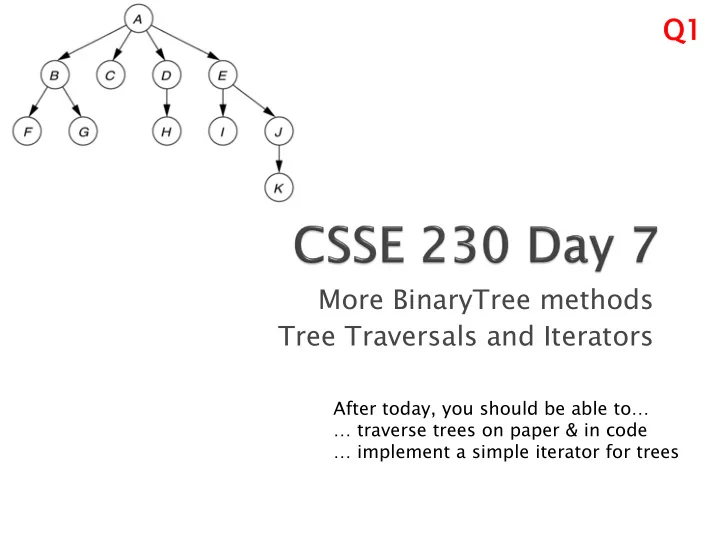

Q1 Q1 More BinaryTree methods Tree Traversals and Iterators After today, you should be able to… … traverse trees on paper & in code … implement a simple iterator for trees
Why must I use a StringBuilder? ◦ Strings are immutable. If you build your string character-by-character by using s += “*” It is like growing an array using the +1 scheme ◦ StringBuilders have internal capacity. If you build your string character-by-character using a StringBuilder, sb.append (“*”) It is like growing an array using … ◦ Not again?!
NULL 1 possibility for children: Both 4 possibilities for children (leaf, Left only, Right only, Both) (which could be NULL_NODE)
Simpler Simpler
Comment out unused tests and uncomment as you go Write containsNonBST(T item) now.
If (node is null) ◦ Return something simple Recurse to the left Recurse to the right Combine results with this node
If (node is null) ◦ Return something simple Recurse to the left Recurse to the right Combine results with this node
If (node is null) ◦ Return something simple Recurse to the left Recurse to the right Combine results with this node
Print the tree If (node is null) contents ◦ Return something Sum the values of simple the nodes Dump the contents Recurse to the left to an array list Recurse to the right Lots more Combine results with this node In what order should we print nodes?
2-6 InOrder (left-to-right, if tree is spread out) ◦ Left, root, right PreOrder (top-down, depth-first) ◦ root, left, right PostOrder (bottom-up) ◦ left, right, root LevelOrder (breadth-first) ◦ Level-by-level, left-to-right within each level
If the tree has N nodes, what’s the (worst- case) big-Oh run-time of each traversal?
6 Brainstorm how to write: public ArrayList<T> toArrayList() Then BST toString() will simply be: return toArrayList().toString();
Otherwise, you’ll need a loop. Examples: Lazy iterators (next class): ◦ use a stack too. AVL trees (week 4): ◦ use pointer to parents to move up tree and “rebalance” Threaded trees: ◦ A tree that uses pointer to next in-order nodes
In Java, specified by java.util.Iterator<E>
Q7 Q7-8 What if we want to iterate over the elements in the nodes of the tree one-at-a-time instead of just printing all of them?
Recommend
More recommend